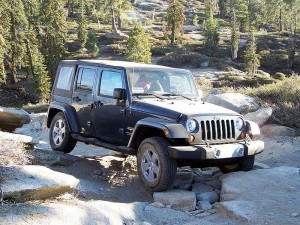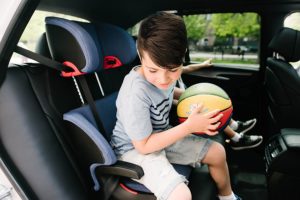 Who
Who
Albert E. Dempsey, 51, was pronounced dead at Bay Medical Center Sacred Heart Health System on Thursday, September 24th, 2015 from a collision that occurred on Thomas Drive at 12:20 PM in Panama City Beach, Florida. He was driving a 2007 Toyota FJ Cruiser and killed in a side impact collision.
The vehicle that drove into him was a 2012 4-door Jeep Wrangler driven by Jack C. Payne, 43, from Ringgold, Georgia. Payne survived and was treated at a hospital for minor injuries. He was later charged with a felony on October 22nd for driving unlicensed during a crash that led to a death.
How
Per FHP reports and images from News Herald and WJHG, Dempsey had been facing east in the driveway access for the Dick’s Wings parking lot close to Coastal Palm Boulevard. He was stopped and waiting for an opportunity to turn southbound on Thomas Drive.
Payne was heading south in the outer lane, left the roadway to the right (i.e., westbound), and impacted the driver’s side of the FJ Cruiser. The Wrangler stopped facing south while the FJ Cruiser stopped facing east.
Eyewitnesses stated that Payne appeared to have been undergoing a seizure while driving shortly before the impact. The witnesses stated he had accelerated after a green light before swerving into Dempsey’s SUV. The witnesses had been driving alongside Payne, and stated they could see Payne undergoing what appeared to be a medical issue while they passed the collision.
When officers arrived at the scene, Dempsey was unconscious and a Dick’s employee had held his head in place in order to keep his airway clear, while Payne screamed due to leg and chest injuries. Both occupants were wearing seat belts and alcohol did not factor into the collision.
Why
This is yet another sad case in which a confluence of factors led to an unnecessary auto death. Payne apparently suffered a medical episode, he was driving a dangerously modified vehicle, his vehicle did not offer any form of frontal crash prevention, and most importantly, he was driving without a license. Let’s look at these issues after considering the crash forces that led to this unfortunate loss of life.
The FJ Cruiser
The 2007 FJ Cruiser is a safe vehicle to be in during a side impact collision. At 14.5 cm, its side impact intrusion resistance wouldn’t earn it a spot on the 2015 list of safest SUVs for side impacts (the highest-ranking SUV there had a post-crash B-pillar to driver’s seat gap of 26 cm), and it’s just over half of the value of the current vehicle leader, the 2017 Q7 at 27 cm, but it’s more than good enough to be classified as “good”, structurally, by the IIHS (their threshold is 12.5 cm), and it also has a “good” side impact score overall as well as side airbags with head and torso protection in the front seats.
This is as good as one could expect for a vehicle made in 2007, and it is crucial to note that any vehicle rated “good” in its side impact score overall by the IIHS, regardless of its side impact intrusion resistance, is one where you would expect to survive (and indeed walk away from) a 31 mph t-bone collision by a 3300 lb SUV (e.g., a Honda CR-V). That is the survivability standard of a good side impact score. Or to put it as simply as possible, there was nothing wrong with Dempsey’s vehicle. It’s crucial to note that his FJ Cruiser did come with side airbags, as they were optional in the 2007 FJ Cruiser and did not become standard until the 2008 model year. We know his FJ Cruiser came with side airbags because they’re visible post-deployment in the pictures above.
With that said, the FJ Cruiser was designed to handle 143.7KJ of kinetic energy in a side impact collision safely. In my experience calculating forces, individuals tend to survive up to 200% of designed force tolerances in their vehicles. Above that, however, survival odds drop significantly; I’d estimate the survival rate at 300% of expected forces drops to somewhere around 33-50%. Around how many KJ of energy did Payne’s Wrangler transfer?
The 2012 4-door Wrangler weighs around 4365 lbs, depending on the trim level. It comes with a “good” frontal score. Given the likely speeds of the collision (I’ll estimate ~45 mph), the collision likely imparted at least 401KJ of energy into the FJ Cruiser / Wrangler. The standard side impact test simulates 143KJ of energy (a 3300-lb sled impacting a vehicle at 31 mph). In other words, the FJ Crsuier faced 279% of the force it would have experienced in the types of crashes cars are rated to make survivable. Given these forces, despite the seemingly minor degree of vehicular intrusion, it is sadly understandable that Dempsey succumbed to his injuries, even with the use of seat belts.
Payne’s survival was expected, in contrast, as he experienced a frontal impact that featured survivable forces. The Wrangler would have been expected to perform safely in a 316KJ collision, which means that Payne experienced 127% of tested forces. His survival was almost guaranteed as a result.
The Medical Episode
However, additional factors tipped the odds against Dempsey. For starters, presuming Payne had indeed suffered a medical episode, it was purely bad luck that he ran into Dempsey to begin with, rather than merely off the road. Beyond that, he could have been traveling at significantly more than 45 mph, if, as witnesses noted, his seizure began from shortly after his acceleration past the green light; every additional mph would have significantly increased the forces Dempsey experienced (remember that forces quadruple as speeds double), significantly reducing his odds of survival.
The Modified Wrangler
Beyond the apparent medical issue, Payne was also driving a dangerously modified vehicle. This video shows the difference between a stock Wrangler and two lifted / raised Wranglers that are “only” 4 inches taller. The higher a vehicle is, the more of a risk it poses to other vehicles because it becomes a.) more likely to bypass crash-resistant structures (bumpers, reinforced steel, crumple zones) in other vehicles, and b.) more likely to override other vehicles in frontal collisions.
The first image clearly shows the absurd height of the Wrangler; the top of its nose is significantly higher than the window sill of a comparable mid-sized SUV, the FJ Cruiser, suggesting it was raised by at least 4 inches, if not more. Along with the speed of the Wrangler, the increased height of it almost certainly directly contributed to Dempsey’s death, as it reduced the amount of protection the FJ Cruiser’s door and body frames could provide by towering above them.
Raised vehicles have no place on public streets. They reduce the effectiveness of crash-resistant structures and place everyone driving normally-dimensioned vehicles at significantly greater risk of injury and death.
Ironically, given that Payne’s Wrangler had also been modified with a door deletion, he would almost certainly have died in a much milder side impact collision, given the near-complete absence of any side impact-protection whatsoever in his Wrangler. The Wrangler, by the way, is also one of the few vehicles still sold new in the US without side airbags as a standard feature.
The Lack of Autobrake
Beyond these factors, it would have been helpful if Payne’s Wrangler had come with some form of frontal crash prevention, as autobraking software is specifically designed to stop vehicles from running into other objects. Granted, current autobrake technology is only rated at up to 25 mph by the IIHS, but it does still retain some effectiveness at higher speeds, depending on the company’s technology, and any mph reduction could have potentially given Dempsey a fighting chance at life.
The Unlicensed Driver
Finally, and perhaps most importantly, Dempsey would almost certainly have lived if Payne had not been driving to begin with. He shouldn’t have been driving to begin with because he didn’t have a driver’s license. Unfortunately, there are thousands of unlicensed drivers on our roads every day.
Takeaways
None of this brings Dempsey back. But knowing what we know about the circumstances of the crash suggests that it could have been prevented or at least ameliorated a number of ways. Unfortunately, it’s difficult for us to protect ourselves from the unsafe choices of other drivers and their vehicles. My main suggestions for keeping yourself and loved ones safe on the road remain to:
1.) Avoid driving (e.g., by using public transportation or by cycling or walking…eventually this leads to a critical mass where everyone is safer by having fewer multi-ton machines speeding everywhere).
2.) Limit driving (by the same measures above and by combining trips…it’s a significant part of why many European countries like Norway have far lower driver death rates than we do).
3.) Drive safely (by wearing your seat belt, driving the speed limit or slower, driving without distractions, driving sober, using your headlights 24/7, checking before entering intersections…basically, these tips).
3.) Drive the safest vehicles possible (by choosing, at a minimum, vehicles with side airbags and electronic speed control).
—
If you find the information on car safety, recommended car seats, and car seat reviews on this car seat blog helpful, you can shop through this Amazon link for any purchases, car seat-related or not. Canadians can shop through this link for Canadian purchases.

 If you find my information on best practices in car and car seat safety helpful, you can buy my books here or do your shopping through this Amazon link. Canadians can shop here for Canadian purchases. It costs nothing extra to do so, but when you shop through my links, a small portion of your purchase, regardless of what you buy, will go toward the maintenance of The Car Crash Detective.
If you find my information on best practices in car and car seat safety helpful, you can buy my books here or do your shopping through this Amazon link. Canadians can shop here for Canadian purchases. It costs nothing extra to do so, but when you shop through my links, a small portion of your purchase, regardless of what you buy, will go toward the maintenance of The Car Crash Detective.





 Who
Who
 Who:
Who:
 Who:
Who: